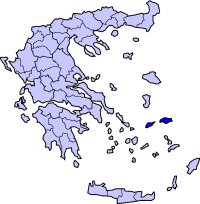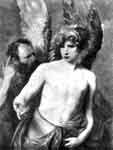And having put in to the island of Doliche, he saw the body of Icarus washed ashore and buried it, and he called the island Icaria instead of Doliche. Apollodorus, Library and Epitome (ed. Sir James George Frazer)
Icaria, also spelled Ikaria (Greek: ) locally Nikaria or Nicaria (Νικαριά), previous name: Doliche (Δολίχη), is a Greek island 10 nautical miles (19 km) south-west of Samos. It derived its name from Icarus, the son of Daedalus in Greek mythology, who fell into the sea nearby. It is one of the biggest islands of the eastern Aegean, 255 mile² (660 km²) in area with 102 miles (160 km) in coastline and a population of about 7,000 inhabitants. The topography is a contrast between verdant slopes and barren steep rocks. The island is mountainous for the most part. It is traversed by Aetheras range, whose highest summit is 1,040 metres. Most of its villages are nestled in the plains near the coast, with only some of them on the mountains. Icaria has a tradition in the production of strong red wine. Many parts of the island are covered by large bushes, especially ravines, making the landscape lush with green. There are no rare species of fauna on the island. Besides pets, only small goat herds make their presence known, disturbing the serenity of the island with their bells. Icaria's climate is considered mild.
"Be careful Icarus!", Daedalus and Icarus, Sir Anthony Van Dyck Icaria has been inhabited since at least 7000 B.C. when it was inhabited by the Neolithic pre-hellenic people that Greeks called Pelasgians. Around 750 B.C. Greeks from Miletus colonized Ikaria establishing a settlement in the area of present day Campos, which they called Oenoe for its wine. In the sixth century B.C. Icaria was absorbed by Samos and became part of Polycrates' sea empire. At this time the temple of Artemis at Nas, on the northeast corner of the island was built. Nas was a sacred spot to the pre-Greek inhabitants of the Aegean, and an important port of the island in antiquity, the last stop before testing the dangerous seas around Icaria. It was an appropriate place for sailors to make sacrifices to Artemis, who among other functions, was a patron of seafarers. The temple stood in good repair until the middle of the 19th century when it was pillaged by the villagers of Christos, Raches for marble for their local church. In 1939 it was excavated by the Greek archeologist Leon Politis. During the German and Italian occupation of Icaria in the Second World War many of the artifacts unearthed by Politis disappeared. Local custom has it that there are still marble statues embedded in the sand off the coast. In the 14th century A.D. Ikaria became part of a Genoese Aegean empire. At one stage, during this time, the Ikarians actually destroyed their harbours to deter the aggressive visitors. According to local historians, the Ikarians left to their own devices, built seven watchtowers around the coast. As soon as a hostile or unknown sail was seen, the watchers immediately lit a fire and then ran to a cistern that was always filled with water. They pulled out a wooden bung in the bottom and the water, of course, began to leak out. The garrisons of the other towers had been alerted by the fire to do the same thing at the same time. Inside each cistern in each castle were identical lines, like those on a measuring jar. Each of these calibrations had a different message attached to it: "pirates attacking", "unknown sail approaching", etc. When the water level reached the level of the appropriate message, the senders rebunged the cistern and put out the fire and everyone in the other towers could read off the size and proximity of the danger. During this time, the Ikarians seldom built villages. Each house was remote from its neighbour, had only one door and was barricaded behind high walls. A working chimney could be a giveaway, so they endured smoke-filled rooms which were kept bare of lootable belongings. Tradition promises that everyone slept on the floor and hid their belongings in niches in the walls. Men and women wore much the same clothes: woven linen skirts for the women, kilts for the males. This lifestyle is said to have procured longevity, and also classlessness. The Knights of St. John, who had their base in Rhodes, exerted some control over Ikaria until 1521 when the Ottoman Empire incorporated Ikaria into its realm. The Ikarians hanged the first Turkish tax collector, but somehow managed to escape punishment.
George Spanos of Evdilos, Ikarian Revolutionary Leaders
In Commemoration of Ikarian Revolution of 1912, Flag of the Free State of Ikaria (1912) The Turks imposed a very loose administration, not sending any officials to Ikaria for several centuries. The best account we have of the island during these years is from the pen of the Bishop J. Georgirnees who in 1677 described the island with 1,000 inhabitants who were the poorest people in the Aegean. In 1827 Ikaria broke away from the Ottoman Empire, but was forced to accept Turkish rule a few years later. It remained part of the Ottoman Empire until July 17, 1912 when the Ikarians expelled a Turkish garrison and thereby achieved independence. George Spanos of Evdilos gave his life in this successful rebellion - killed in a Turkish ambush on July 17 - and is honored as the hero of the Ikarian Revolution (his bust, depicting him with bandoliers and defiant rifle in hand, may be seen in the National Resistance Square in Evdilos). On July 18, 1912 the Free State of Ikaria was declared. The neighboring islands of Fournoi Korseon were also liberated and became part of the Free State. Ioannis Malachias was the first and only president of the short-lived nation. For five months, it remained an independent state, with its own armed forces, flag, stamps, and anthem. These five months were difficult times. There were food shortages, the people were without regular transportation and postal service, and they were at risk of becoming part of the Italian Aegean empire. But in November 1912, after a delay due to the Balkan Wars, Ikaria became part of Greece.
Icarian Sea The island suffered tremendous losses in property and lives during the Second World War and the Italian and then German occupation. There are no exact figures on how many people starved, but in the village of Karavostamo alone, over 100 perished from starvation. The ravages of W.W. II were followed by those of the Greek Civil War (1945-1947), fought between the nationalists and the communists. Subsequently, the Greek government used the island to exile about 13,000 communists. To this date (2005), many (but far from all) of the islanders have remained sympathetic to communism, and, for this reason, Ikaria is referred to by some as the Kokkino Nisi (Greek: Κόκκινο νησί), Red Island or the Kokkinos Vrahos (Greek: Κόκκινος Βράχος), Red Rock. The quality of life improved greatly after 1960 when the Greek government began to invest in the infrastructure of the islands assisting in the promotion of tourism. Despite a difficult history, which during different eras involved defending against pirate attacks, surviving a 400-year Turkish occupation, war, civil war, starvation, and poverty, the spirit of the Ikarians has never been broken, it has survived, overcome, and prevailed. Ikarians exhibit a great pride in their island and a love of family and education. Many Ikarians and their descendants have gone on to great success - whether success is defined as the achievement of wealth or power (both at home and abroad) or as the overcoming of great obstacles to achieve a balanced life. Ikarians pursue not only work but also the pleasure of being with family and friends, enjoying together a cup of coffee or a shot of ouzo accompanied by octopus or kalamari (caught earlier that day from Ikarian waters), a glass (usually more than a glass) of wine and good food, including bread right out of the town baker's oven, fruits and vegetables cut fresh from the gardens, and grapes from the vineyards. Ikarians look forward to the various Saint's days when, in the central square of different towns and villages, they can feast and dance the "Kariotiko" throughout the night to the music of live bands featuring the violin and bouzouki. Time, for most Ikarians, is something to enjoy and savor with good company and surrounded by nature and the beauty of the mountains and the Aegean Sea. Time is not something to worry about or be driven by. The word “deadline” is unknown to most Ikarians. One can never be late, because one can never be expected to be anywhere at any given moment in time. To most visitors, this is, at first, disconcerting and often frustrating; later it is liberating. Most people who have been to Ikaria for any length of time do not want to leave, and, when they must, they dream of returning. And whether they are able to return or not, it is often sufficient, wherever they may find themselves, to have experienced Ikaria, to know that it exists, and to know that they can return to it, if only in mind, and free themselves of the concerns and stresses created by the demands of today's fast-moving, modern societies.
Main Harbour with Icarus monument
Livadi, Turtles
Church in Icaria
Armenistis, Ikaria Communities and settlements
Persons Icarian Dance Group Ikaria Island National Airport Links
 |
|
||||||||||||||||
|
|













